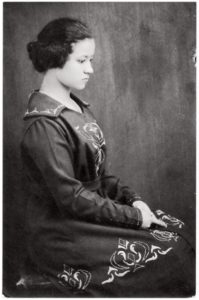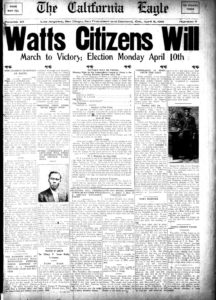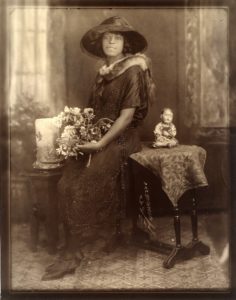In celebration of the 2022 Black History Month, I’ve been learning more about the pioneering Black women photographers in our country. Read on to learn more about 3 women who made history in different ways. One was a family photographer, another was a photojournalist and the last was an artist and filmmaker.
Florestine Perrault Collins
 The first photographer I discovered and now greatly admire is Florestine Perrault Collins (1895-1988). She was a photographer in New Orleans in the early 1900s and her studio work supported her family through the Great Depression when many others faltered. Because she was a woman, of course, she was blocked from photographing news events. But that enabled her to serve her community more beautifully by using her talents to create family portraits that became part of the history and legacy of many New Orleans families. Read more about her.
The first photographer I discovered and now greatly admire is Florestine Perrault Collins (1895-1988). She was a photographer in New Orleans in the early 1900s and her studio work supported her family through the Great Depression when many others faltered. Because she was a woman, of course, she was blocked from photographing news events. But that enabled her to serve her community more beautifully by using her talents to create family portraits that became part of the history and legacy of many New Orleans families. Read more about her.
Vera Jackson
While Collins specialized in family portraits, Vera Jackson (1912-1999) was a photojournalist. She was inspired by her father who was an avid reader and photographer. He reminds me of my own father who started every day reading the newspaper and also inspired me with his photography! Vera’s father made sure that his daughter was connected with African-American newspapers at a young age. His influence sparked her interest in photography. Vera enrolled in a government-sponsored photography program and also took photography classes at her local high school.
 She took her education one step further and also learned to print and enlarge her photos. This was great preparation for a career as a photojournalist. She worked as an assistant to photographer Maceo Sheffield and started her photojournalist career with the California Eagle, an African-American newspaper that was operated by Charlotta Bass, a pioneering publisher, editor, and civil rights activist. The California Eagle was groundbreaking because it provided photos taken by black photographers intended specifically for black readers. Jackson’s work with Charlotta Bass would transform her photojournalistic work into activism. Read more about Vera Jackson.
She took her education one step further and also learned to print and enlarge her photos. This was great preparation for a career as a photojournalist. She worked as an assistant to photographer Maceo Sheffield and started her photojournalist career with the California Eagle, an African-American newspaper that was operated by Charlotta Bass, a pioneering publisher, editor, and civil rights activist. The California Eagle was groundbreaking because it provided photos taken by black photographers intended specifically for black readers. Jackson’s work with Charlotta Bass would transform her photojournalistic work into activism. Read more about Vera Jackson.
Madame E. Toussaint Welcome
Jane Louise Van Der Zee Toussaint Welcome (1885-1956) was a pioneering visual artist and filmmaker. She started life in Massachusetts as Jennie Louise Van Der Zee, moving to New York with her parents who would be employed by President Ulysses S. Grant as maid and butler. It was in New York that Jennie met her life partner – Ernest Toussaint Welcome, an inventor and entrepreneur. They married and became an artistic power couple that would be instrumental in the Harlem Renaissance.
 Jennie would become the first African-American owner of a business in Harlem which at that time was home to mostly white families. Her Toussaint Conservatory of Art and Music in Harlem was an art school and photographic studio that thrived for over 40 years. She would be instrumental in teaching countless children to express themselves through art and music.
Jennie would become the first African-American owner of a business in Harlem which at that time was home to mostly white families. Her Toussaint Conservatory of Art and Music in Harlem was an art school and photographic studio that thrived for over 40 years. She would be instrumental in teaching countless children to express themselves through art and music.
She also found a creative outlet in filmmaking and became one of the only African-American women filmmakers in the silent film industry. Jennie and her husband were making newsreels like most of the filmmakers in Harlem at that time. On June 8, 1916, the Toussaint Motion Picture Exchange announced their film about African-American soldiers fighting overseas titled Doing Their Bit. The film recognized the African-American contributions to World War I that were unknown to many.
The Toussaint Welcomes were leaders in the Harlem Renaissance that existed from around 1910 to the 1930s. Harlem was home to the emergence of black photographers and artists who showcased their black subjects in ways that reflected dignity and personal pride, in contrast to those by white photographers. Read more.
![]()
Grateful for these sources: https://hundredheroines.org and Viewfinders: Black Women Photographers by Jeanne Moutoussamy-Ashe, Photo Credit for photo of Madame E. Toussaint Welcome – James VanDerZee, Evening Attire, 1922, gelatin silver print, Smithsonian American Art Museum, Museum purchase through the Julia D. Strong Endowment and the Smithsonian Institution Collections Acquisition Program, 1994.57.3



0 Comments